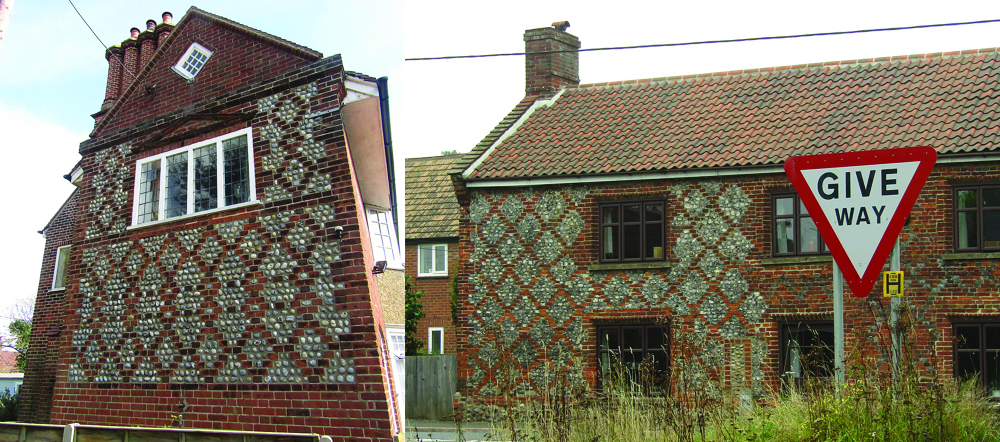Diapering in Construction
| Diaperwork or diapered flint by Kolforn under Creative Commons Attribution-Share Alike 4.0 International license |
Diapering in construction also called diaperwork refers the decorative treatment of a surface or facade with a repeating pattern of squares or chequers or rectangles. The terms stems from the latin 'dia' meaning across, describing the diagonal perpenicular lines creating diamond patterns.
It origins lie in Medieval times, often combining a flint stone wall with brick infill creating the repetitive pattern, an later with differing shades or materials of brick. It was a technique often used in Gothic and Tudor architecture often seen on churches, castles, and some houses to denote status and craftsmanship.
Diapering and the resulting geometric patterns can improve the visual interest of a facade, giving more depth and breaking the monotony of plain brick or flint surfaces surfaces and thus aesthetic value. It has also been used to create specific patterns or motifs that might represent the owner of the building such as guilds, religions, families or clans.
The technique to some extent can contribute to the structural integrity of a wall, with the interlocking patterns acting as structural ribs, distributing loads more evenly and potentially improving environmental resistance. Diapering might still be used today, often on brick facades likewise to add interest to plain brick surfaces. The employment of diapering today may be executed traditionally on site by a skilled brick layers or flinters (a flint worker) often on traditional buildings or off-site in the pre-production of modular building elements, brought to site and installed separately.
[edit] Related articles on Designing Buildings
- Airbrick.
- Aircrete blocks.
- Basic brickwork replacement.
- Blockwork.
- Bricklayer.
- Brick bats and closures.
- Brick burr.
- Brick sizes.
- Brick strip foundation.
- Brick veneer.
- Bungaroush.
- Cavity wall.
- Chalk aquifer.
- Clay.
- Clunch.
- Damp-proof course.
- Defects in brickwork.
- Dismantling of bricks for reuse.
- Efflorescence.
- Frog.
- Frost attack.
- Federation of Master Builders.
- How to lay bricks.
- Knapping.
- Limestone for building.
- Master mason.
- Masonry.
- Mortar.
- Pointing.
- Spalling.
- Specifying brick.
- Swift brick.
- The influence of geology on English brickmaking,
- Testing bricks.
- Treating brickwork with sealant or water repellent.
- Types of brick arches.
- Types of brick bonding.
- Types of bricks.
- Types of stone.
- Which way up should you lay a brick?
- Wall tie failure.
Featured articles and news
Ebenezer Howard: inventor of the garden city. Book review.
The Grenfell Tower fire, eight years on
A time to pause and reflect as Dubai tower block fire reported just before anniversary.
Airtightness Topic Guide BSRIA TG 27/2025
Explaining the basics of airtightness, what it is, why it's important, when it's required and how it's carried out.
Construction contract awards hit lowest point of 2025
Plummeting for second consecutive month, intensifying concerns for housing and infrastructure goals.
Understanding Mental Health in the Built Environment 2025
Examining the state of mental health in construction, shedding light on levels of stress, anxiety and depression.
The benefits of engaging with insulation manufacturers
When considering ground floor constructions.
Lighting Industry endorses Blueprint for Electrification
The Lighting Industry Association fully supports the ECA Blueprint as a timely, urgent call to action.
BSRIA Sentinel Clerk of Works Training Case Study
Strengthening expertise to enhance service delivery with integrated cutting-edge industry knowledge.
Impact report from the Supply Chain Sustainability School
Free sustainability skills, training and support delivered to thousands of UK companies to help cut carbon.
The Building Safety Forum at the Installershow 2025
With speakers confirmed for 24 June as part of Building Safety Week.
The UK’s largest air pollution campaign.
Future Homes Standard, now includes solar, but what else?
Will the new standard, due to in the Autumn, go far enough in terms of performance ?
BSRIA Briefing: Cleaner Air, Better tomorrow
A look back at issues relating to inside and outside air quality, discussed during the BSRIA briefing in 2023.
Restoring Abbotsford's hothouse
Bringing the writer Walter Scott's garden to life.
Reflections on the spending review with CIAT.
Retired firefighter cycles world to raise Grenfell funds
Leaving on 14 June 2025 Stephen will raise money for youth and schools through the Grenfell Foundation.
Key points for construction at a glance with industry reactions.























